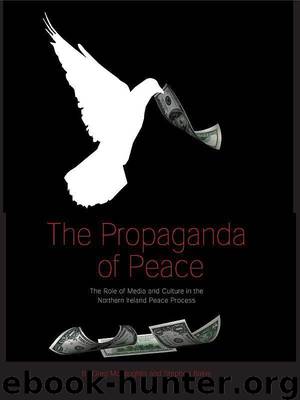The Propaganda of Peace: The Role of Media and Culture in the Northern Ireland Peace Process by Stephen Baker & Greg McLaughlin

Author:Stephen Baker & Greg McLaughlin
Language: eng
Format: mobi
Publisher: Intellect Ltd.
Published: 2011-03-29T23:00:00+00:00
Film and television drama
The dramatic contrast in imagery between ‘strife-torn maelstrom’ and ‘blissful, rural idyll’, typifies two of the most prevalent, visual representations of Ireland in the 20th Century and, as John Hill (1987) has shown, it is the former image that has dominated cinematic portrayals of the North. The Carol Reed film, Odd Man Out (Reed 1947), is an antecedent of this tradition. The film follows Johnny McQueen, a leader of the ‘organisation’ (a euphemism for the IRA), who is wounded in an armed robbery and escapes into the city before he and his sweetheart, Kathleen, are shot by the police, their romantic intentions unfulfilled. While Hill acknowledges the film’s very distinctive visual style, he argues that its narrative is typical of cinematic representations of the Irish conflict, in that it ignores political and historical context, reducing violence to ‘a manifestation of the Irish “national” character’ (Hill 1987: 149) and maintaining rigid ideological closure.
However, what has been termed ‘ceasefire cinema’ appears to offer films with at least some moral and political ambiguity in their representation of the paramilitary, if not the violence he deploys. This is much in the same way as we have seen in the NIO’s confidential telephone adverts, Lady and Wanna Be Like You, but without, perhaps, such overtly propagandistic images and messages. Much of the ambiguity arises out of a mixture of genres and generic conventions that make a straightforward propaganda analysis impossible. Instead, we can draw a much clearer distinction based on a relation between genre and subject matter: in other words, a mix of crime thriller and horror among those films that feature loyalist paramilitaries; and political thriller and melodrama among those concerned mainly with republicans.
Of course, this has ideological consequences for how the subject matter is dealt with. Film portrayals of loyalist paramilitaries as underworld criminals (Nothing Personal – O’Sullivan 1996) or psychopathic monsters (Resurrection Man – Evans 1998) reinforce dominant caricatures of loyalists as being driven or sometimes even trapped by venal motivations and constraints rather than informed by a political ideology or manifesto. By contrast, a mix of the political thriller/melodrama in films such as Love Lies Bleeding (Winterbottom 1993) and The Boxer (Sheridan 1997) accommodates the republican subject as a man in control of his destiny, the narrative driving him in a direction away from violence towards a peaceful settlement, whether in the political or domestic sphere. In a sense, such contradistinctive, generic portrayals reflect the mood of the period, the 1990s, with loyalism low in political confidence and wracked by violent internal feuds and dissent, all in stark contrast to their more politically confident and united republican counterparts.
Download
This site does not store any files on its server. We only index and link to content provided by other sites. Please contact the content providers to delete copyright contents if any and email us, we'll remove relevant links or contents immediately.
Asking the Right Questions: A Guide to Critical Thinking by M. Neil Browne & Stuart M. Keeley(5649)
Autoboyography by Christina Lauren(5184)
Eat That Frog! by Brian Tracy(4436)
Dialogue by Robert McKee(4323)
Sticky Fingers by Joe Hagan(4103)
Journeys Out of the Body by Robert Monroe(3572)
Annapurna by Maurice Herzog(3424)
Full Circle by Michael Palin(3389)
Schaum's Quick Guide to Writing Great Short Stories by Margaret Lucke(3321)
Elements of Style 2017 by Richard De A'Morelli(3307)
The Art of Dramatic Writing: Its Basis in the Creative Interpretation of Human Motives by Egri Lajos(3017)
Atlas Obscura by Joshua Foer(2900)
The Diviners by Libba Bray(2887)
Why I Write by George Orwell(2877)
In Patagonia by Bruce Chatwin(2876)
The Fight by Norman Mailer(2848)
The Mental Game of Writing: How to Overcome Obstacles, Stay Creative and Productive, and Free Your Mind for Success by James Scott Bell(2845)
Venice by Jan Morris(2526)
The Elements of Style by William Strunk and E. B. White(2442)
